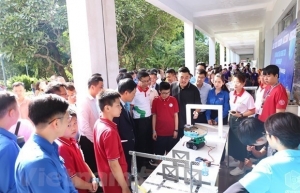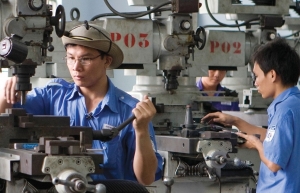Human resources and the ties to vocational education
The increase in population has led to a sharp increase in the number of people of working age. Vietnam’s technical workforce has greatly improved in sci-tech, taking on the majority of complex work positions in production and business.
 |
| Dao Trong Do, Continuing training director General Directorate of Vocational Education and Training Ministry of Labour, Invalids, and Social Affairs |
Among more than 52 million workers of working age, the percentage of the trained labour force with degrees and certificates reached 26.8 per cent this year, an increase of more than 2.5 times compared to 2000.
At present, Vietnam has over 1,900 technical and vocational education and training institutions, which includes over just over 1,000 vocational centres. A network of training institutions and vocational education institutions has been formed nationwide, with a variety of occupations and training methods, innovative training programmes linked to the labour market.
In the coming years, with the digital economy and the impact of Industry 4.0, along with the changes in employment requirements and skills of workers, Vietnam must overcome a number of challenges in human resources, especially high-quality human resources in a number of key industries and new technologies.
The proportion of workers in Vietnam with university degrees or higher accounts for 10.9 per cent, college 3.7 per cent, intermediate school 4.3 per cent, and elementary school 4.7 per cent.
For every person who goes to university, there are only 0.42 people in vocational education, which also means there is more indirect labour (university) than labour (vocational education). This means the work of streamlining and career orientation for students after high school education still has many shortcomings.
The LinkedIn 2023 Global Green Skills Report shows that all 48 countries surveyed have workers holding green jobs or listing at least one green skill on their LinkedIn profiles. This group has a 29 per cent higher chance of finding a job than people without green skills.
In August, the government issued a resolution to develop a project for human resources for the semiconductor industry towards 2030, and train 30,000-50,000 human resources and experts in the industry.
A 2019 employment survey also forecast that by 2025, the total workforce in the country will be 59.2 million people, including 3.2 million workers with primary vocational qualifications, and four million workers with college degrees. By 2030, the total workforce in the country will be 61.9 million people, of which 3.1 million workers will have primary vocational qualifications and 7.1 million workers will have college degrees.
Linking vocational education with the actual needs of businesses has been a focused of the General Directorate of Vocational Education and Training (DVET) for many years. As a result, vocational training programmes are designed to approach the needs of the market, helping learners equip themselves with the skills required by businesses, especially as Vietnam is an attractive destination with many foreign businesses.
The opportunities for internationalisation in vocational education are very promising. Vietnam’s participation in many international trade agreements has also opened up opportunities for vocational education to approach foreign businesses and interact with the foreign working environment.
Successful integration into this process requires human resources to meet the requirements of enterprises in general and foreign-invested enterprises (FIEs) in particular. Right from the time of training, vocational education institutions must cooperate with enterprises to learn and grasp the skills that enterprises require, take advantage of the strengths of machinery and equipment of enterprises to innovate, and develop training programmes suitable for each level.
The DVET and the Ministry of Labour, Invalids, and Social Affairs have signed with many corporations, associations, large enterprises, FIEs, and agencies of Japan, South Korea, and elsewhere on training and the supply of trained workers.
Currently, the DVET is also gradually promoting international cooperation in vocational education and training, encouraging vocational education institutions to strengthen cooperation with FIEs to accelerate the process of international integration in labour.
Going forward, the DVET aims to expand and improve the effectiveness of comprehensive cooperation between Vietnam and other countries and international organisations in vocational education and training.
The DVET will step up the negotiation, signing and implementation of cooperation agreements and programmes with international partners and foreign-invested enterprises operating in Vietnam in supporting vocational education institutions, students, and colleges to strengthen their professional skills.
 | Vietnam wants high-quality human resources training in STEM Vietnam needs a comprehensive investment strategy and support policies to encourage universities to invest in the education of high-quality STEM (Science, Technology, Engineering and Mathematics) professionals, thereby laying the groundwork for the country's scientific and technological advancement, educational experts have said. |
 | Support necessary to boost green human resources A vibrant and dynamic vocational education and training system is crucial to Vietnam meeting its socioeconomic development goals. Jen Bahen, education and research counsellor at the Australian Embassy in Vietnam, told VIR’s Hoang Oanh about Australia’s support in vocational training and human resource building. |
What the stars mean:
★ Poor ★ ★ Promising ★★★ Good ★★★★ Very good ★★★★★ Exceptional
Related Contents
Latest News
More News
- Businesses ramp up production as year-end orders surge (December 30, 2025 | 10:05)
- Vietjet chairwoman awarded Labour Hero title (December 29, 2025 | 13:06)
- How to unlock ESG value through green innovation (December 29, 2025 | 10:03)
- AI reshapes media and advertising industry (December 29, 2025 | 08:33)
- FPT and GELEX sign deal to develop blockchain tech for global markets (December 29, 2025 | 08:29)
- Vietnam’s GDP forecast to grow by 9 per cent in 2026 (December 29, 2025 | 08:29)
- Women entrepreneurs are key to Vietnam’s economic growth (December 29, 2025 | 08:00)
- Vietnam's top 500 value-creating enterprises announced (December 27, 2025 | 08:00)
- The PAN Group shaping a better future with ESG strategy (December 26, 2025 | 09:00)
- Masan Consumer officially lists on HSX, marking the next phase of value creation (December 25, 2025 | 13:20)

 Tag:
Tag:




















 Mobile Version
Mobile Version